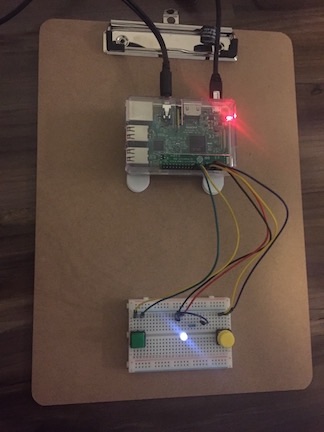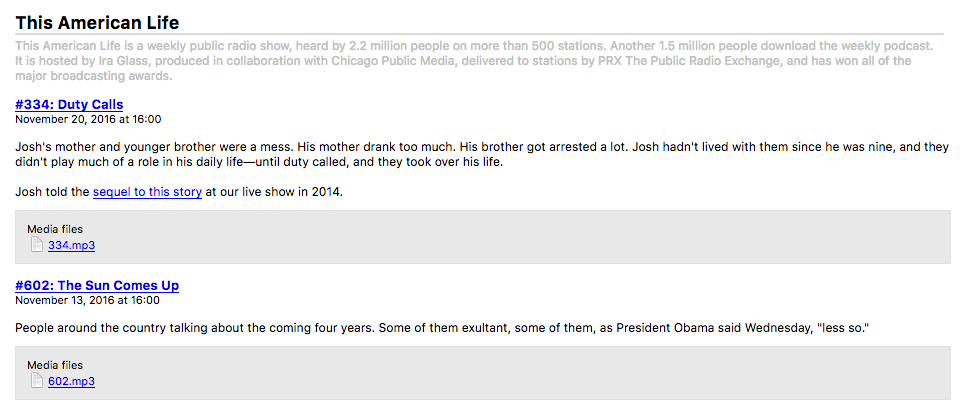Podcast Player, overview
I’ve got this stereo that was built before I was born. There’s no touchscreen or keyboards. It has physical buttons dedicated to functions. They each feel different. Each media has its own device: a Tape Player, a CD Player, and a Record Player.
I also listen to a lot of podcasts, so I wanted to build a similar physical device dedicated to podcasts, like, a, uh, Podcast Player.
Project
I’m building the Podcast Player using a Raspberry Pi, a tiny computer that’s easy to hook up to a breadboard. Here’s the first version:
Eventually I’d like to build up a physical box to blend in with the rest of the stereo, with a LCD and nice-feeling buttons. But for now, I’ve put together a prototype that can download and play Podcasts using a few buttons.

Beautiful!
Heads up, I’m still working on the project. But, having learned from my handful unpublished drafts of previous projects, I’m going to break this one into a few smaller installments.
In this post, I’ll give an overview of the project and what’s left.
Use Cases
The Podcast Player could do many different things, but I narrowed it down to three main use cases:
- I want to be able to press a button, and a podcast start playing.
- If I’ve heard the podcast already, I should be able to mark it as played and never hear it again. Then I should be able to start playing the next most recent podcast.
- If I want to hear a specific podcast, I should be able to scroll through the list of podcast channels, choose one, and start playing the most recent podcast from that channel.
To do these, I needed some way to download and annotate podcasts.
Podcast management library
I wrote a Podcast management library that handled downloading and annotating podcasts. I can say more about it, and I’ll try to in a follow-up post, but in this post, I’ll focus on how it relates to the rest of the Podcast Player.
Podcasts usually have an RSS feed that lists new podcasts. So I give
the library a list of podcast feeds to visit, and it checks them for
new podcasts and downloads them. I can schedule this to run every few
hours using cron.

Along with managing downloads, it records information about the podcasts. It can show the most recently published podcast in the library, and where that podcast is located on my system. It also deletes a podcast when I tell it to, and notes down not to download that podcast again.
I had fun with this part, trying out type hinting and thinking about state machines, but the novel part of this project for me was building the physical box.
Raspberry Pi
The Raspberry Pi provides a ton of features out of the box, like WiFi and an audio jack. Given those, my project leaned on the software side of things. For electronics I just needed two buttons.
I bought a few electronics: breadboards, LEDs, resistors, wires, and buttons. It’s nice because they’re just a few dollars each, but it was tricky to get the right combination of things. I bought the wrong type of jumper cables. I have a LCD, but I don’t have a soldering iron yet so I can’t do anything with it.
Once I had the right things, it went smoothly. There are a lot of resources and YouTube videos about hooking electronics up to the Raspberry Pi. I wired up an LED and some buttons and coded them to do things.
With that, I had the podcast data and knew how to code the Raspberry Pi. I just needed a little script to glue it all together. But that little script started growing, so I built some libraries to help me.
Menu UI

For the first iteration of the Podcast Player, I won’t have a display, a dial, or very many buttons, so I’m using two buttons and audio.
One button rotates through the menu items, and the other selects
items. Every time it moves to a new item, it “highlights the item”, or
in this case, reads the item’s title using the text-to-speech program
espeak. The audio menu is reminiscent of a phone menu’s “Press 3
for…”
I wrote a little class to help with the menu. It also supports sub-menus, and “back” buttons. It worked pretty well, and didn’t use much code.
I wrote those and a few other helper classes to work with the Buttons, so all that’s left is putting it all together.
The remaining 10% of the project
My next two milestones is making this work end-to-end with one podcast, and then making it work for the rest of the podcasts I want it to download . I see two hurdles left before I have something working end-to-end.
I need to populate a menu based on the Podcast library. I’m still
deciding whether to have a Python API, or follow the cron setup and
just make calls to the CLI. The API sounds right.
Also, I need to figure out how I want to run a menu program while playing podcasts. I want to be able to pause or stop the podcast and mark it as done with the buttons. Time to dive into subprocesses.
Once I have something working end-to-end, the podcast management library will need some work before I’ll call this project done. It works great with the single podcast feed, but every time I add a new podcast channel, I run into issues: one podcast has huge files that take a long time to download; another had a key missing from its feed. I might look into using an external library for this.
Seeya
I’m going to see if I can wrap up this project during the long weekend.
After playing with the Raspberry Pi, and building a box I can interact with in the real world, I have a few other Raspberry Pi projects in mind. I’ve also bumped up the priority of reading The Design of Everyday Things since realizing how much I have to learn about designing user interfaces.